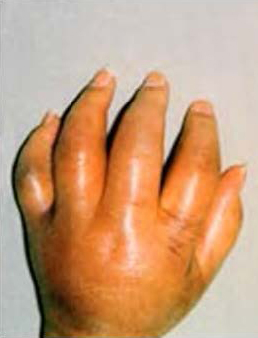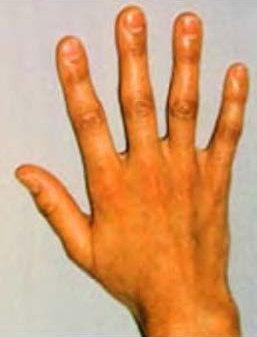Patient case studies
BMS Matrix Therapy used to heal CRPS
Before treatment


After treatment


By Dr. med. Fernanda Mendes Cardoso
written on 26.02.2014
Link to original article at jameda.de Germany’s largest Doctor recommendation website
Sudeck’s disease or complex regional pain syndrome (CRPS) is a difficult to treat, tedious disease. The colloquially still common term Morbus Sudeck was replaced by the term “Complex Regional Pain Syndrome” (CRPS).
What is Sudeck’s disease or the “complex regional pain syndrome”?
Sudeck’s disease causes inflammatory overheating, swelling and neuropathic pain on the arm or leg. The often months long course of Sudeck’s disease is characterized by increasing stiffening, pain and muscle atrophy. For differential diagnosis, Sudeck’s disease is the subject of laboratory tests and radiological examinations to rule out other causes. The painful disease process can lead to the loss of limbs in extreme cases. A joint is always involved in Sudeck’s disease, for example a forearm with a hand or a lower leg with ankle joint.
Triggers and causes of Sudeck’s disease are unclear
The causes of Sudeck’s disease are not yet clear. There is always a trauma (bone fracture or similar) or surgery ahead. In Sudeck patients one always finds an excess activity of the sympathetic nervous system with an increased secretion of stress hormones into the affected tissue. This ensures lack of regeneration and a generally catabolic metabolism with dissolution of the tissue. Depression, stress or life crises are often discussed as potential causes of complications.
The symptom-oriented standard therapy of Morbus Sudeck
Because the triggers of Sudeck’s disease are unknown, symptom-oriented medication is used to decongestant and alleviate pain. In addition, the sympathetic nervous system is regulated by a so-called “tributary blockade”.
Cell biological analysis of the development of Sudeck’s disease
In the view of cell biological regulatory medicine, the cause of Sudeck’s disease lies in an excessive activation of the sympathetic nervous system with disturbance of the microcirculation. The metabolism of the cells in the affected locomotor system is characterized by sympathetic catabolic (ie by the metabolism). The course of the disease with vegetative dysregulation and swelling to cell death is accompanied by a disturbance of the microcirculation in the affected tissue. The mass transport in the extracellular matrix of the tissues is ensured by the constant microvibration of the muscle fibers as a muscle-driven peripheral pump. Normally 2-5% of all muscle fibers are active even at rest at a frequency of 8-12 Hz. (The Microvibration, Dr. Hubert Rohracher, Vienna 1969).
Stagnation of microcirculation as the cause of Sudeck’s disease
If the microvibration is disturbed, the congestion of the microcirculation known in Sudeck’s disease arises. Metabolic end products are no longer removed. Nutrients and oxygen no longer reach the cells. In the anaerobic situation, the cells convert to lactic acid fermentation. The toxic lactic acid is transported into the extracellular matrix, and triggers by local hyperacidity the characteristic pain for Sudeck’s disease and the reactive inflammation.
Cell biological therapy in Sudeck’s disease: activation of microcirculation
The treatment of Sudeck’s disease using the ZRT-Matrix therapy was developed in a rehab clinic. It is a proven therapy for more than 10 years. The basic module of the therapy is the biomechanical stimulation: A vibration entry in the biological frequency range in the adjacent healthy tissue. The goal of the therapy is the replacement and the re-integration of the lost muscular rhythm. The external vibration input stimulates the muscles as the main driver of microcirculation again. The biomechanical stimulation in the context of cell biological interpretation of the Sudeck disease is thus a local and causal therapy of Sudeck’s disease.
Course of therapy in Sudeck’s disease
The therapy is carried out by therapists certified in Cell Biological Regulation Therapy. The vibration therapy is set on the body (proximal) in the healthy tissue of the affected area. From there it is slowly proceeded to the diseased area. After about 6 therapy sessions a significant improvement in Sudeck’s disease should have occurred. By base wraps, the local acidosis is treated concomitantly. Likewise, a heat treatment by wIRA (water-filtered infrared) is recommended. Again, the disease must be irradiated proximal adjacent healthy tissue again. Overall, 12-18 sessions are usually required at the therapist.
© Joint Clinic Gundelfingen – translated from the original German text